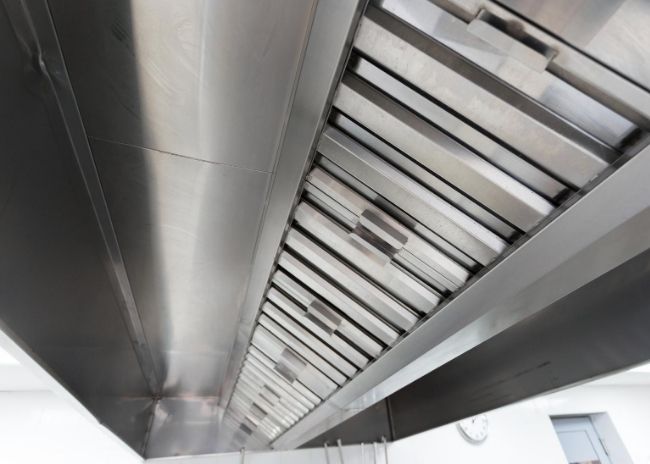Kitchen ventilation systems are used in commercial cooking applications to remove cooking heat and effluent. Professionally sized and installed, components include stainless-steel exhaust hoods, exhaust fans, makeup air units, grease removal apparatuses, fire-suppression systems and controls.
Hoods are custom designed for each application and equipment lineup. These operate from above the cook line and include grease filtration capabilities to extract particles from the airstream. Hoods also release cooking odors outside of the building.
This equipment is categorized by use. Type I ventilation systems are rated for positioning over grease-producing appliances, while Type II units, or vapor hoods, are rated for heat and steam over dishwashers and some oven types.
Hood size and shape depend on the equipment beneath it. Low proximity-style hoods sit closer to appliances and are typically used in quick-service restaurants with fryer banks or in kitchens with low ceilings. Island-style hoods are suitable for middle-of-the-room placement.
Pollution control systems remove smoke, grease and odors before they reach the airstream. The two types include a filter-style unit that utilizes carbon and an electrostatic reciprocator. The latter charges particles as they go through the unit and collects them while using carbon for odor removal.
There are different filtering options or grease removal apparatuses available, from low-tech baffle systems to high-efficiency extractors. The type that is appropriate for a specific kitchen depends on the ventilation process, system design and necessary level of grease extraction. Utilizing more filters can help control grease buildup.
Ventilation systems come equipped with exhaust fans that can mount on either the facility’s roof or an outside side wall. Belt or direct drive fans are available.
Makeup air units represent another component of a ventilation system. When unbalanced or poorly designed, kitchen exhaust systems can allow heat and smoke to spill into the kitchen, negatively impacting air quality, back-of-house temperatures and utility bills. The load generated by cooking units will determine how much makeup or replacement air is necessary to balance the environment. A lack of replacement air creates negative pressure in the kitchen, which can compromise the operation of cooking equipment.
Operators can choose from four types of systems that minimize the air velocity around the hood: One system brings in untempered air from outside into the kitchen, another brings in outside air and heats it, a system is available that brings in outside air and cools it, and another both heats and cools outside air, depending on the temperature needed. Dedicated outside air systems represent another option and provide complete temperature and humidity control of makeup air.
Ventilation systems’ fire suppression equipment and controls typically incorporate tanks of chemical agents mechanically activated to contain or extinguish fires. Newer systems have unlimited water supplies for this purpose. Also, bigger hoods with more overhang and end panels can help contain fires.
Demand control kitchen ventilation (DCKV) automatically varies the system’s operation to accommodate peak and down periods. This is accomplished with heat only, where sensors or optics measure the heat differences between the hood and the room.
Due to sanitation requirements, hoods need to be either 100% stainless steel or the unit’s exposed areas must feature stainless steel construction. Automated cleaning systems are available, and an ultraviolet light option helps break down grease in high-volume applications.




